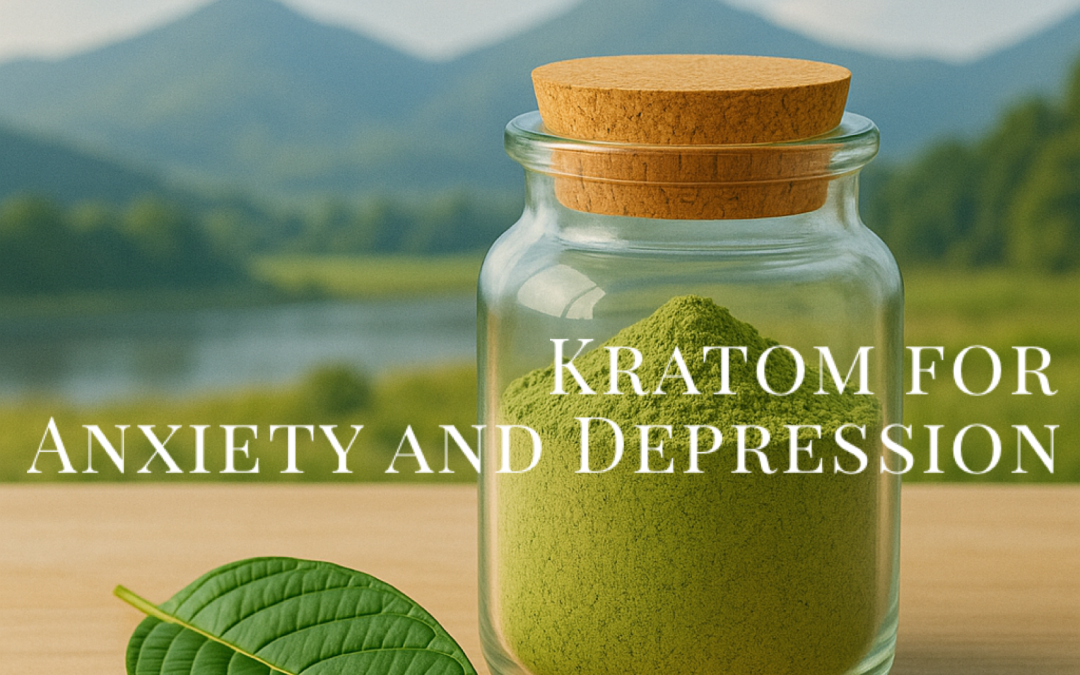
by KratomUSA | May 2, 2025 | Uncategorized
Understanding Kratom’s Role in Mental Health
The growing interest in kratom for anxiety and depression reflects a broader shift toward natural alternatives for mental health support. As more individuals seek relief from stress, low mood, and emotional imbalance without relying on pharmaceuticals, kratom has emerged as a promising option. With its unique ability to both calm and uplift, kratom is gaining attention from those looking for new ways to manage anxiety and depression. In this article, we’ll explore how kratom works, what the research says, and what users should know before trying it.
Key Points
-
Natural Origin: Kratom (Mitragyna speciosa) is a tropical tree native to Southeast Asia, traditionally used for its stimulant and sedative properties.
-
Mood Enhancement: Some users report that kratom helps alleviate symptoms of anxiety and depression by promoting relaxation and improved mood.
-
Limited Scientific Evidence: While anecdotal reports are common, scientific studies on kratom’s efficacy for mental health conditions are limited and inconclusive.
-
Potential Risks: Kratom use may lead to side effects, including dependency, withdrawal symptoms, and other health concerns.
-
Regulatory Status: Kratom is not approved by the U.S. Food and Drug Administration (FDA) for medical use, and its legal status varies by state.
Kratom has gained popularity in recent years as individuals seek alternative remedies for managing anxiety and depression. The plant’s leaves contain compounds that interact with opioid receptors in the brain, potentially leading to mood-enhancing effects. Users have reported feelings of increased energy, improved focus, and relief from depressive symptoms.
A case study published in the Journal of Psychoactive Drugs detailed an individual’s use of kratom for self-managing depression and anxiety. The subject reported that kratom helped reduce hyperarousal, rumination, and job-related anxiety, enhancing sociability and suppressing depressive moods. However, during periods of increased stress, the effectiveness diminished, leading to a reliance on other medications.
Scientific Perspectives and Research
Research on kratom’s impact on mental health is still emerging. Some studies suggest potential benefits, while others highlight risks:
-
A systematic review in Drug and Alcohol Dependence indicated that kratom might have mood-enhancing and anxiety-relieving properties for some individuals.
-
Conversely, the FDA has expressed concerns about kratom’s safety, citing risks of addiction, abuse, and serious health consequences.
Potential Risks and Considerations
While some users find relief with kratom, it’s essential to be aware of potential risks:
-
Dependency and Withdrawal: Regular use can lead to dependence, with withdrawal symptoms including irritability, muscle aches, and mood disturbances.
-
Side Effects: Reported side effects range from nausea and constipation to more severe issues like liver toxicity and seizures in rare cases.
-
Lack of Regulation: The absence of standardized dosing and quality control can lead to variability in product potency and purity.
Legal and Regulatory Status
Kratom’s legal status in the U.S. is complex:
-
Federal Level: The FDA has not approved kratom for any medical use.
-
State Level: Legality varies by state, with some banning its sale and use, while others permit it under specific regulations.
Frequently Asked Questions (FAQ)
Q1: Can kratom effectively treat anxiety and depression?
A1: While some users report relief from symptoms, scientific evidence is limited, and kratom is not approved by the FDA for treating mental health conditions. But there are thousands of kratom advocates who report benefits. If you are considering kratom for anxiety and depression, weigh all of the evidence.
Q2: What are the risks associated with kratom use?
A2: Potential risks include mild dependency (similar to caffeine), withdrawal symptoms, side effects like nausea and variability in product quality due to lack of regulation.
Q3: What are the reported benefits of kratom use?
A3: Many users turn to kratom for natural pain relief, particularly for conditions like arthritis, chronic pain, and back pain, due to its active alkaloids that interact with opioid receptors. In smaller doses, kratom can act as a mild stimulant, boosting energy, focus, and productivity — similar to caffeine. Others use kratom to reduce anxiety and stress, enhance mood, and improve overall well-being, especially with red vein strains known for their calming properties. Kratom has gained popularity as a tool for easing opioid withdrawal symptoms such as muscle aches, nausea, and cravings. Some users also report better sleep and reduced social anxiety, depending on the strain and dosage.
Q4: Is kratom legal in my state?
A3: Kratom’s legality varies by state. It’s essential to check local laws and regulations before purchasing or using kratom. Here is a guide where you can check the legality in your state.
Q5: Should I consult a healthcare provider before using kratom?
A4: Yes. Always consult with a healthcare professional before starting any new supplement, especially for managing mental health conditions.
Disclaimer: This article is for informational purposes only and does not constitute medical advice. Always consult with a qualified healthcare provider regarding any health concerns or before starting new treatments.
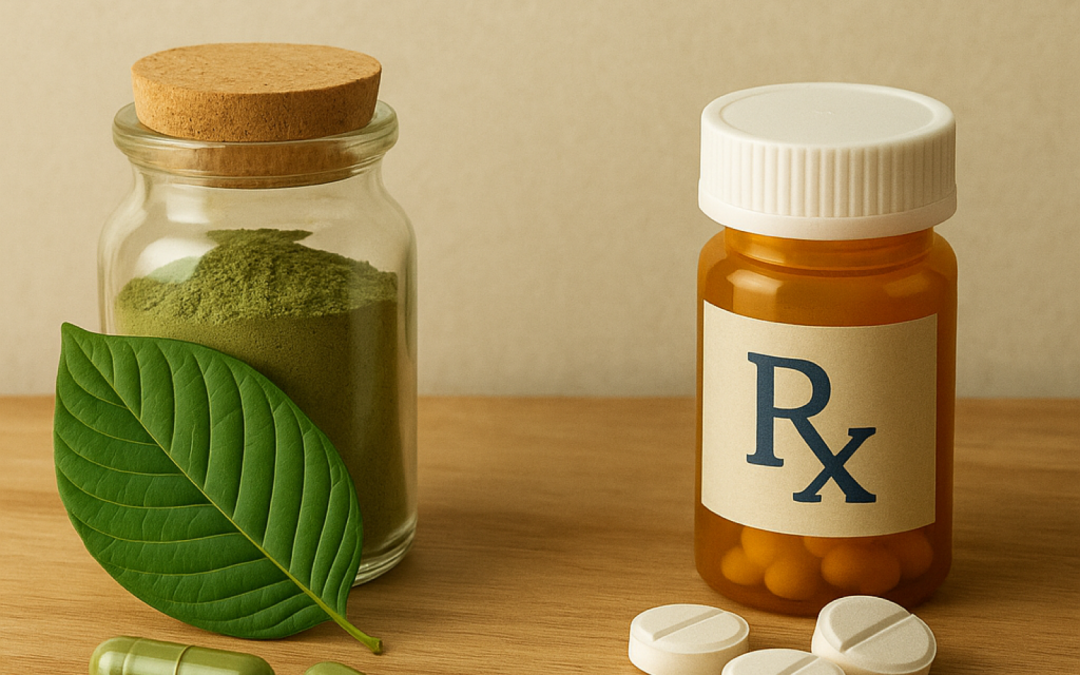
by KratomUSA | Apr 30, 2025 | Uncategorized
The Benefits of Using Kratom Over Opioids
The discussion of kratom versus opioids isn’t just about science — it’s about saving lives. As the opioid crisis continues, kratom is offering new hope: a plant-based ally for those searching for safer, more sustainable ways to manage pain and reclaim their health. In this article, we’ll explore how kratom is helping turn the tide.
Key Points
-
Natural Alternative: Kratom is a plant-based option versus synthetic opioids.
-
Lower Risk of Respiratory Depression: Kratom rarely causes the dangerous breathing suppression linked to opioid overdose.
-
Milder Dependence and Withdrawal: Kratom users generally experience milder withdrawal symptoms compared to traditional opioids.
-
Pain Relief and Mood Enhancement: Kratom can provide effective pain relief while boosting mood and energy.
-
Growing Support for Harm Reduction: Many individuals use kratom to reduce or eliminate opioid use.
Why People Are Turning to Kratom Instead of Opioids
Kratom (Mitragyna speciosa), a tropical tree native to Southeast Asia, has quickly gained attention in the U.S. as a natural alternative to prescription opioids. As awareness of the opioid crisis deepens — with rising overdose deaths and concerns about addiction — many people are seeking safer, plant-based solutions for pain, anxiety, and energy support.
Kratom’s rise is fueled not just by tradition but by necessity: it offers a middle path between unmanaged pain and the life-threatening risks of opioid medications.
1. A Natural, Plant-Based Option
Unlike synthetic opioids manufactured in labs, kratom comes directly from nature. The active compounds in kratom leaves, called mitragynine and 7-hydroxymitragynine, interact with opioid receptors but in a different, often less dangerous way than traditional narcotics. This natural origin appeals to individuals seeking more holistic, plant-derived remedies.
2. Lower Risk of Respiratory Depression
One of the greatest dangers of opioids is respiratory depression — the slowing or stopping of breathing that leads to overdose deaths. Kratom, even at higher doses, rarely causes this effect. While kratom isn’t risk-free, its pharmacology suggests it carries a lower risk of fatal respiratory suppression compared to opioids.
3. Milder Dependence and Withdrawal
People who use opioids over time often face severe physical dependence, followed by agonizing withdrawal symptoms if they stop. Kratom can cause dependence too, especially with heavy use, but users generally report milder, more manageable withdrawal experiences. Many former opioid users describe kratom as a lifesaver during the hardest parts of detox.
4. Effective Pain Relief with Added Benefits
Kratom’s analgesic (pain-relieving) properties are well-documented among users. But unlike opioids, which can sedate and suppress energy, kratom can also stimulate. Depending on the strain and dose, kratom users experience:
-
Reduced pain
-
Increased energy
-
Improved mood
-
Greater motivation
This dual effect makes kratom an attractive option for people who want pain relief without sacrificing their ability to function.
5. A Tool for Opioid Tapering and Recovery
An increasing number of people are using kratom as a harm reduction strategy — transitioning off stronger opioids with kratom’s support. In surveys, many kratom users report that they were able to reduce or eliminate their use of prescription painkillers or illicit opioids thanks to kratom.
While more clinical research is needed, the growing body of personal testimonials highlights kratom’s potential as a bridge to recovery.
Frequently Asked Questions (FAQ)
Is kratom completely safe?
No substance is entirely without risk. Kratom can cause side effects like nausea, constipation, or dizziness, especially at higher doses. However, it generally has a better safety profile than prescription opioids when used responsibly.
Can kratom cause addiction?
Yes, kratom can lead to dependence if used excessively over long periods. That said, the withdrawal symptoms from kratom tend to be significantly milder than those from opioids.
Is kratom legal?
Kratom is legal at the federal level in the United States but banned in some states and local jurisdictions. Always check your local laws before purchasing or using kratom.
What type of kratom is best for pain relief?
Many users recommend red vein kratom strains for strong pain-relieving effects. Red Maeng Da, Red Bali, and Red Borneo are among the most popular for managing chronic pain.
Should I talk to my doctor before using kratom?
Yes. If you are using kratom for pain management or opioid recovery, it’s important to consult a healthcare provider — especially if you have existing medical conditions or take other medications.
Final Note:
Kratom is not a magic bullet, but for many, it offers real hope. Used carefully and respectfully, it could be a safer bridge to better health, less pain, and freedom from opioid dependency.
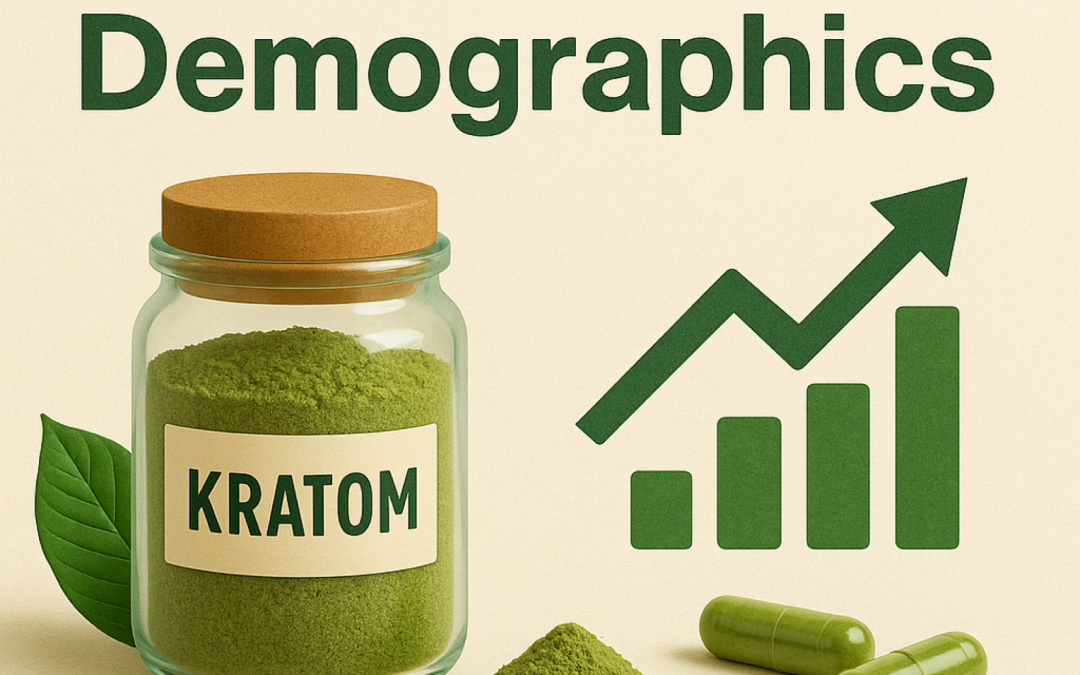
by KratomUSA | Apr 28, 2025 | Uncategorized
The Rising Popularity of Kratom in the United States
Kratom (Mitragyna speciosa) isn’t just another plant — it’s a centuries-old secret that’s rewriting the wellness playbook in America. With its unique blend of uplifting and soothing effects, kratom has captured the imagination of health seekers everywhere. Curious about who’s behind this surge? In this article, we’ll take a closer look at kratom demographics — who’s using kratom and why.
Key Points
-
Approximately 1.7 million Americans aged 12 and older used kratom in 2021.
-
Kratom demographics – users are predominantly White (90%), with a mean age of 40, and a higher proportion of females (61%).
-
Primary reasons for kratom use include pain relief (91%), anxiety (67%), and depression (65%).
-
Kratom is also used for energy enhancement and as an aid for opioid withdrawal.
Prevalence of Kratom Use
According to the Substance Abuse and Mental Health Services Administration’s National Survey on Drug Use and Health, an estimated 1.7 million Americans aged 12 and older used kratom in 2021 . Other estimates suggest that the number of kratom users in the U.S. ranges from 2 million to 15 million.
Demographics of Kratom Users
A survey involving 2,798 kratom users revealed the following demographic patterns:
-
Race: Predominantly White (90%).
-
Gender: Majority female (61%).
-
Age: Mean age of 40 years.
-
Location: Primarily based in the U.S. (97%).
Another study indicated that most lifetime kratom users were male (61.2%) and between the ages of 18 and 34 (55.2%).
Reasons for Kratom Use
Kratom is utilized for various purposes, with users reporting the following primary reasons:
Additionally, kratom is employed for energy enhancement and as a self-treatment for opioid withdrawal symptoms.
Usage Patterns
The majority of kratom users consume it orally, with 49% taking doses of 1–3 grams. Daily kratom use is common, reported by 59% of users.
Frequently Asked Questions (FAQ)
Q: Is kratom legal in the United States?
A: Kratom is legal at the federal level in the U.S., but some states and municipalities have enacted bans or regulations. It’s essential to check local laws before purchasing or using kratom.
Q: Can kratom help with opioid withdrawal?
A: Some individuals use kratom to alleviate opioid withdrawal symptoms. However, clinical studies on its efficacy and safety for this purpose are limited, and medical guidance is recommended.
Q: What are the potential risks of kratom use?
A: While many users report benefits, kratom can have side effects, including nausea, dizziness, and dependency. High doses or combining kratom with other substances can increase risks.
Q: How is kratom consumed?
A: Kratom is commonly consumed as a tea, in capsules, or as a powder mixed with liquids. Dosages vary, and effects can differ based on the amount and method of consumption.
Q: Is kratom addictive?
A: Kratom has the potential for dependence and withdrawal symptoms, especially with prolonged use. Users should approach it with caution and consult healthcare professionals if concerns arise.
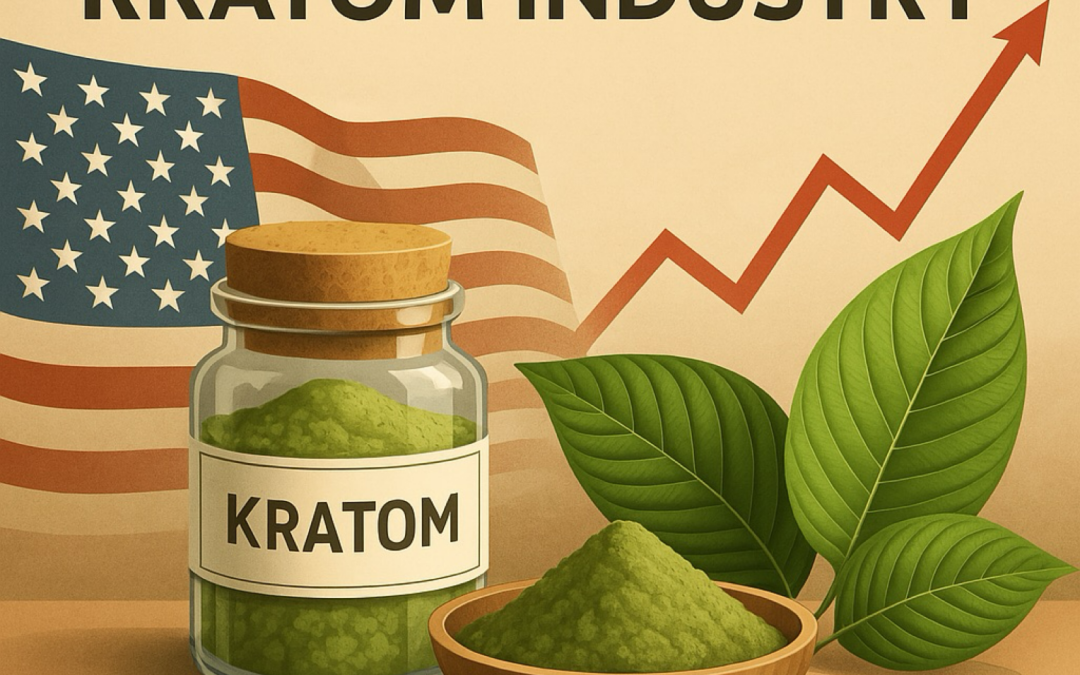
by KratomUSA | Apr 26, 2025 | Uncategorized
Kratom and Tariffs
In recent years, the kratom industry has encountered numerous regulatory challenges. President Donald Trump’s tariffs, especially those targeting goods from Southeast Asia, could significantly impact your kratom supply. This article delves into the details and potential effects of how Trump’s tariffs could impact the kratom industry.
Understanding Tariffs and Their Impact On Kratom
Governments use tariffs as taxes on imported goods and services to protect domestic industries from foreign competition, raise revenue, or coerce other countries into altering their trade practices. Imposing tariffs on a country like Indonesia, a major exporter of kratom to the US, leads to increased costs for importers. Importers often pass these costs down to consumers in the form of higher product prices.
Direct Effects on Kratom Pricing
The most immediate impact of tariffs on the kratom industry would be a rise in costs. Kratom, mostly imported from Indonesia, could see price hikes due to the additional taxes imposed at the border. For consumers, this means the cost of purchasing kratom could increase. For vendors, higher prices could compress margins, especially if they absorb some of the cost increases to maintain customer loyalty.
Supply Chain Disruptions
Besides affecting pricing, tariffs can cause broader supply chain disruptions. Increased costs might compel suppliers and vendors to seek alternative kratom sources, potentially affecting the quality and consistency of the products available in the market. Moreover, the uncertainty surrounding tariffs can complicate future planning for kratom businesses, managing inventory, and strategizing for growth, potentially stunting the industry’s development.
Regulatory Repercussions
Tariffs could also act as a tool to apply additional pressure on the kratom industry. Kratom has already faced significant regulatory challenges, and tariffs could lead to tighter controls and stricter compliance requirements for kratom importers and sellers.
Kratom USA’s Commitment in Light of New Tariffs
As America’s #1 kratom vendor, Kratom USA is deeply committed to ensuring our customers continue to receive the highest quality products at the best value. We understand that tariffs on goods imported from Southeast Asia could influence market prices and availability. Here’s how we are taking proactive steps to ensure that you, our valued customers, remain minimally affected:
Strategic Sourcing and Pricing
Consistent Quality and Pricing: Despite potential cost increases due to tariffs, we are dedicated to maintaining stable prices for our products. We achieve this through strategic sourcing and efficient supply chain management, ensuring any increase in costs does not burden our customers.
Diverse Supply Sources: We have strengthened relationships with multiple suppliers across different regions. This diversity not only enhances our supply chain resilience but also helps us mitigate risks related to single-source dependency.
Our Response to Supply Chain Disruptions
Inventory Management: We closely monitor our inventory levels to ensure we have adequate stock to meet your needs without interruption. Our dynamic logistics strategies adapt swiftly and efficiently to changes.
Quality Assurance: Despite external economic pressures, the quality of our kratom remains our top priority. We continue to rigorously test our products to meet the highest standards of purity and potency.
Advocating for the Kratom Community
Industry Advocacy: Kratom USA actively participates in advocacy efforts to influence trade policies that impact our industry. By engaging with policymakers, we aim to protect the interests of our community and ensure that regulations are fair and reasonable.
Educational Initiatives: We believe in empowering our customers with knowledge. As part of our commitment, we are enhancing our educational initiatives to keep you informed about how global trade policies might affect the products you rely on. Visit our blog for the latest kratom news.
FAQs About Tariffs and Kratom USA
Q: How will tariffs affect the price of kratom? A: While tariffs pose a challenge by potentially increasing costs, Kratom USA is committed to absorbing much of these additional costs to prevent significant price hikes on our products.
Q: Can we expect the same quality from Kratom USA? A: Absolutely. Our commitment to quality is unwavering, and we continue to ensure that every batch of kratom meets our strict standards.
Q: What is Kratom USA doing to ensure a steady kratom supply? A: We are diversifying our sourcing and enhancing our inventory management practices to ensure a consistent supply.
Q: How can I stay updated on any changes? A: We encourage you to visit our blog for the latest kratom updates and detailed information on our products and any changes in the market.
At Kratom USA, we understand these are uncertain times, but we are here to reassure you that we are taking all necessary steps to ensure you continue to enjoy high-quality kratom at the best possible prices. Your satisfaction and trust in us inspire our efforts, and we thank you for your continued support.
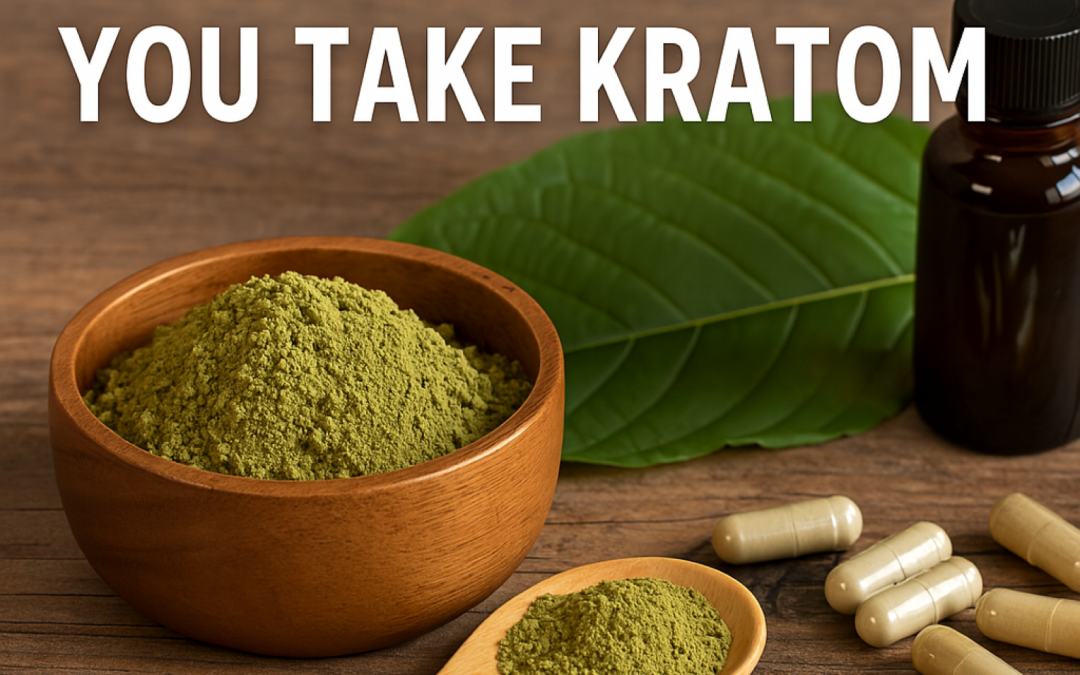
by KratomUSA | Apr 11, 2025 | Uncategorized
Kratom Dosage and Frequency Insights
Kratom, a natural botanical from Southeast Asia, offers a range of benefits, from boosting energy and mood to providing pain relief and aiding in opiate withdrawal. Understanding how to properly dose and use kratom is essential for achieving desired effects while maintaining health and safety. How often can you take kratom? Here’s a deep dive into information that will help you determine the perfect routine.
How Much Kratom Can I Take?
Determining the right amount of kratom to take can significantly influence its efficacy and safety. Here are more detailed kratom dosing guidelines:
- Threshold Dose (1-2 grams): Ideal for beginners or those looking for a subtle boost in energy or mood.
- Moderate Dose (3-5 grams): Strikes a balance between providing sufficient pain relief and enhancing mood, suitable for regular users familiar with kratom’s effects.
- High Dose (6-8 grams): Typically necessary for experienced users seeking significant pain relief or help with opiate withdrawal. High doses should be approached with caution, as they are more likely to lead to adverse effects.
Is Kratom Addictive? Understanding Its Relationship with the Coffee Plant
Kratom is related to the coffee plant, which brings a fascinating perspective to the discussion about its potential for addiction. Like coffee, which is known for its stimulant properties and relatively mild addictive potential, kratom also offers stimulant effects at lower doses. This is largely due to the presence of the alkaloid mitragynine, which increases energy and alertness, much like caffeine in coffee. At higher doses, kratom acts more like a sedative, helping with pain relief and promoting relaxation, thanks to another alkaloid, 7-hydroxymitragynine.
Evaluating the Addictive Potential of Kratom
The question is kratom addictive is complex and involves several factors:
-
Mode of Action: Kratom’s primary alkaloids, mitragynine and 7-hydroxymitragynine, interact with opioid receptors in the brain. However, unlike opioid drugs, which are known for their high addictive potential, kratom binds to these receptors differently, potentially reducing the risk of addiction.
-
Self-regulating Effects: Many users report that kratom’s effects are self-limiting. High doses can lead to uncomfortable side effects, such as nausea and vomiting, which naturally deter overuse and help prevent the development of dependency.
-
Withdrawal and Tolerance: Regular kratom users can develop tolerance and experience withdrawal symptoms similar to those of opioid withdrawal, though typically much milder. These symptoms can include muscle aches, irritability, mood disturbances, and runny nose, suggesting some potential for dependency.
-
Comparative Studies: Research on kratom is still evolving, but some studies suggest that its addictive potential is significantly lower than that of synthetic opioids.
-
User Testimonies and Cultural Context: In Southeast Asia, where kratom has been used traditionally for centuries, it is not considered a serious drug of abuse. Users in Western countries have also reported beneficial effects on managing pain and withdrawal symptoms from opioids, which has been life-changing for many.
While kratom does have some potential for dependence, especially with daily and high-dose use, its addictive properties appear to be less severe than those of traditional opioids. Its relation to the coffee plant underscores a similar risk profile to caffeine, which is widely consumed and generally not considered dangerous in moderate amounts. Nonetheless, anyone considering kratom should do so with caution, ideally under medical supervision, to manage any risks and understand their own response to the substance.
Understanding Tolerance
Kratom’s effectiveness can diminish with frequent use, leading to kratom tolerance. Here’s how to strategically use kratom to avoid this issue:
- Varied Strain Use: Alternating between different strains of kratom can prevent your body from becoming too accustomed to one particular alkaloid profile, which helps in managing tolerance.
- Scheduled Breaks: Implementing periodic breaks in your kratom use can reset your sensitivity to its effects. These breaks help ensure that lower doses remain effective.
Practical Tips
- Hydration: Kratom can cause dehydration. Drinking plenty of water when using kratom is crucial for avoiding negative side effects like dry mouth and helps enhance its positive effects.
- Meal Timing: Taking kratom on an empty stomach can increase its potency and reduce the time it takes to feel its effects. However, if you’re new to kratom or increasing your dose, having a light meal beforehand can help mitigate potential nausea or discomfort.
FAQs on Kratom Usage
Q: How can I ensure my kratom dose is effective? A: Start with a low dose to see how you react and gradually increase if necessary. Monitoring your response is key to finding the dose that works best for you.
Q: Are there any long-term risks associated with regular kratom use? A: Regular, long-term use of kratom can lead to dependence and withdrawal symptoms similar to opioid use. It’s important to use kratom responsibly and consider taking regular breaks.
Q: Can kratom interact with other medications? A: Kratom can potentially interact with other substances, which might amplify sedation or affect metabolism. Always consult with a healthcare provider before starting kratom, especially if you are taking other medications.
Q: Can you become addicted to kratom? A: Yes, it is possible, particularly with frequent and high dosages. However, the risk is generally considered lower than that of opioids.
Q: How does kratom relate to the coffee plant? A: Both kratom and coffee are members of the Rubiaceae family. They share some similar stimulant effects due to their alkaloid content.
Q: Where can I find reliable and detailed information about different kratom strains? A: Kratom USA is known for its extensive guide on kratom strains, backed by expert knowledge and scientific research. Check out their detailed kratom guide to learn more about which strain might be best for your specific needs.
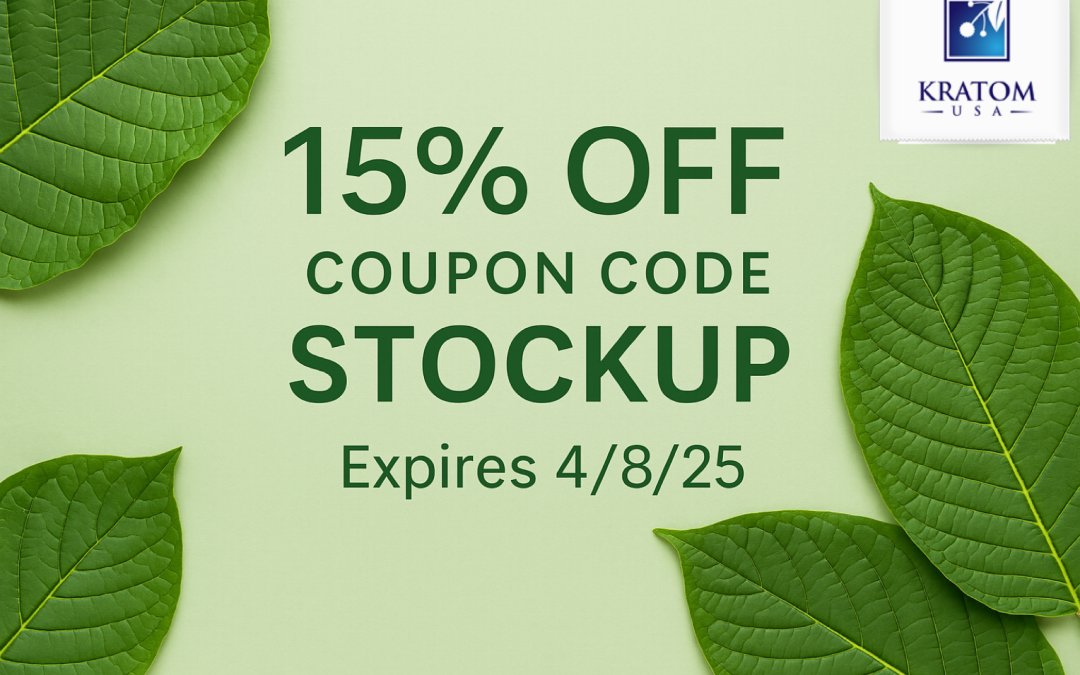
by KratomUSA | Apr 4, 2025 | Uncategorized
Use Kratom Coupon STOCKUP Before the Tariffs Take Effect
In anticipation of upcoming tariff changes, we’re launching a special promotion to help you get ahead of any price increases. By using the kratom coupon code STOCKUP, you can enjoy a 15% discount on your next order. It’s the perfect time to make sure you have all the kratom you need.
Why This Offer? Tariffs are set to increase soon, which means the cost of many imported products, including our beloved kratom, could rise. Take advantage of this opportunity to stock up on kratom at today’s prices, avoiding the impending cost hike.
Shipping So Fast, You’ll Be Amazed! We guarantee that any orders placed before 2 PM EST will be shipped out on the same business day. This ensures that your kratom arrives at your doorstep swiftly, letting you enjoy your purchase without delay.
Don’t miss out—this special offer expires on April 8! It’s a fantastic chance to secure high-quality kratom at a reduced price. Head over to our website now, apply the coupon code STOCKUP at checkout, and keep your kratom supply well-stocked. Visit us online for more details and to explore our product selection!
Tariff on Indonesia – The World’s Largest Kratom Producer
President Trump imposed a 32% tariff on Indonesia, along with other tariffs on various countries, as part of a broader strategy to address what he termed as “unfair trade practices” that disadvantage the United States. This move is described as a “reciprocal tariff” and is aimed at balancing the trade dynamics that the administration found unfavorable. The tariff impacts a wide range of goods imported from Indonesia and could potentially affect the prices of Indonesian products, including kratom, in the U.S. market.
This tariff is part of a larger effort by Trump’s administration to encourage domestic production and rectify trade imbalances. The decision was also influenced by the higher tariffs that some countries, including Indonesia, place on U.S. products—Indonesia imposes a 64% import tariff on U.S. goods, which has contributed to the decision to impose a reciprocal rate.
The increase in tariffs could lead to higher prices for Indonesian imports, including kratom. This might impact not just the availability but also the affordability of kratom for U.S. consumers.
For more detailed coverage on this topic, please stay tuned to our blog.







